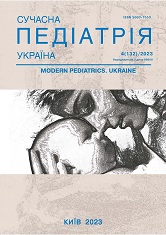Clinical case of alopecia totalis in pediatric practice
DOI:
https://doi.org/10.15574/SP.2023.132.99Keywords:
alopecia, autoimmune polyendocrine syndrome (APECED), immunodeficiency, treatment, obesityAbstract
Alopecia (baldness) is a pathological hair loss. A chronic relapsing course leads to a violation of the emotional sphere of the child, worsens the quality of life. Alopecia is considered autoimmune, since it is characterized by hair loss due to lymphocytic infiltration around the hair follicles. It can be secondary as a result of infectious and inflammatory processes.
Purpose - is to conduct own clinical observation of a child with total alopecia to increase the awareness of doctors about this pathology in children.
Clinical case. The article presents a clinical case of total alopecia in an 11-year-old child. It is known from the anamnesis that in 9 months the child began to lose hair on his head, at 2 years old - eyebrows and eyelashes, at 3 years old he was diagnosed with total alopecia. The patient had a complex clinical and laboratory examination with the involvement of a multidisciplinary team, since alopecia can occur under the mask of autoimmune diseases and immunodeficiencies.
Total alopecia, atopic dermatitis, changes in immunological status in the anamnesis, cases of early mortality among family members, as well as a history of alopecia areata in the father gave us reason to suspect a genetic disease in the patient, including autoimmune polyendocrinopathy candidiasis-ectodermal dystophia (APECED syndrome) with mutation in the AIRE gene.
Conclusions. For verification the diagnosis and choose a treatment strategy, the patient needs an additional examination: sequencing of the relevant locus of the AIRE gene to detect mutations characteristic of APECED syndrome, as well as a serological test to detect the titer of antibodies to Candida and a puncture biopsy of the scalp. Considering the above, the prognosis for recovery is unfavorable. The research was carried out in accordance with the principles of the Declaration of Helsinki. Informed consent of parents was obtained for the study.
No conflict of interests was declared by the authors.
References
FDA. (2018). The Voice of the Patient. A series of reports from the U.S. Food and Drug Administration's (FDA's) Patient-Focused Drug Development Initiative. Alopecia Areata. Center for Drug Evaluation and Research (CDER) U.S. Food and Drug Administration. URL: https://www.fda.gov/media/112100/download.
Ji C, Liu S, Zhu K, Luo H, Li Q, Zhang Y, Huang S, Chen Q, Cao Y. (2018, Aug). HLA-DRB1 polymorphisms and alopecia areata disease risk: A systematic review and meta-analysis. Medicine (Baltimore). 97 (32): e11790. https://doi.org/10.1097/MD.0000000000011790; PMid:30095639 PMCid:PMC6133534
Lee HH, Gwillim E, Patel KR, Hua T, Rastogi S, Ibler E, Silverberg JI. (2020, Mar). Epidemiology of alopecia areata, ophiasis, totalis, and universalis: A systematic review and meta-analysis. J Am Acad Dermatol. 82 (3): 675-682. Epub 2019 Aug 19. https://doi.org/10.1016/j.jaad.2019.08.032; PMid:31437543
Meah N, Wall D, York K, Bhoyrul B, Bokhari L, Sigall DA et al. (2020, Jul). The Alopecia Areata Consensus of Experts (ACE) study: Results of an international expert opinion on treatments for alopecia areata. J Am Acad Dermatol. 83 (1): 123-130. Epub 2020 Mar 9. https://doi.org/10.1016/j.jaad.2020.03.004; PMid:32165196
Serbina IM. (2018). Modern approaches to the treatment of alopecia areata in children. International Medical Journal. 24; 1: 68-73.
Shanshanwal S. (2020, Jul 30). Hair Growth Cycle: The Science Behind Hair Growth. URL: https://www.practo.com/healthfeed/hair-growth-cycle-the-science-behind-hair-growth-41853/post.
Simakou T, Butcher JP, Reid S, Henriquez FL. (2019). Alopecia areata: A multifactorial autoimmune condition. Journal of Autoimmunity. 98: 74-85. URL: https://www.sciencedirect.com/science/article/abs/pii/S0896841118305845. https://doi.org/10.1016/j.jaut.2018.12.001; PMid:30558963
Strazzulla LC, Wang EHC, Avila L, Lo Sicco K, Brinster N, Christiano AM, Shapiro J. (2018, Jan). Alopecia areata: An appraisal of new treatment approaches and overview of current therapies. J Am Acad Dermatol. 78 (1): 15-24. https://doi.org/10.1016/j.jaad.2017.04.1142; PMid:29241773
Strazzulla LC, Wang EHC, Avila L, Lo Sicco K, Brinster N, Christiano AM, Shapiro J. (2018, Jan). Alopecia areata: Disease characteristics, clinical evaluation, and new perspectives on pathogenesis. J Am Acad Dermatol. 78 (1): 1-12. https://doi.org/10.1016/j.jaad.2017.04.1141; PMid:29241771
WHO. (2020). ICD-11 for Mortality and Morbidity Statistics. URL: https://icd.who.int/browse11/l-m/en#/http://id.who.int/icd/entity/1633035058.
Downloads
Published
Issue
Section
License
Copyright (c) 2023 Modern pediatrics. Ukraine

This work is licensed under a Creative Commons Attribution-NonCommercial 4.0 International License.
The policy of the Journal “MODERN PEDIATRICS. UKRAINE” is compatible with the vast majority of funders' of open access and self-archiving policies. The journal provides immediate open access route being convinced that everyone – not only scientists - can benefit from research results, and publishes articles exclusively under open access distribution, with a Creative Commons Attribution-Noncommercial 4.0 international license (СС BY-NC).
Authors transfer the copyright to the Journal “MODERN PEDIATRICS. UKRAINE” when the manuscript is accepted for publication. Authors declare that this manuscript has not been published nor is under simultaneous consideration for publication elsewhere. After publication, the articles become freely available on-line to the public.
Readers have the right to use, distribute, and reproduce articles in any medium, provided the articles and the journal are properly cited.
The use of published materials for commercial purposes is strongly prohibited.

